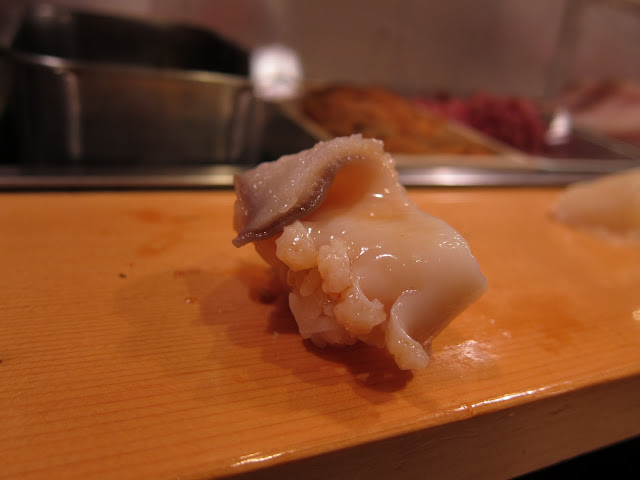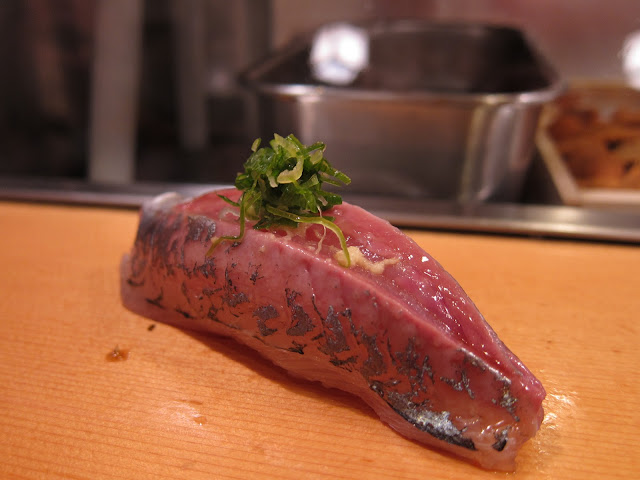I know, I know, I shouldn't have done it. I was only ever going to be disappointed right? Within days of arriving back from Tokyo and eating at the legendary
Sushi Dai, I found myself with an insatiable itch for more of the sushi I had there. Now I must be some sort of masochists because surely, short of hopping on to the next flight to Tokyo, that is one itch that is never going to be satisfied outside of Japan, and surely not in Norway at that?
So it was that Mrs. Nibbler and I found ourselves at Alex Sushi in Oslo. This is one restaurant that I have heard consistently good things about from numerous sources. So when the sushi urge struck, this restaurant was the natural choice. So how disappointed was I then? Well, to be fair, comparing any sushi restaurant outside of Japan with Tokyo's finest is a little unrealistic. However, I was more than surprised that Alex Sushi got remarkably close, and was able to rekindle some of that sushi magic I had experienced in Tokyo. It is probably some of the best sushi I have experienced outside of Japan.
The restaurant itself is quite minimalist, with an industrial feel to it. We sat at the large central sushi bar, which is dominated by a lighting arrangement that looks a little like an upside down viking long boat. Bold artwork on the walls offsets the starkness of the interior. There is also table seating further inside the restaurant and a bar area upstairs. The overall feel was light and airy, with glass, wood and steel being the dominant materials - very Scandinavian and a very pleasant place to while away the evening.
The
menu consists of a la carte selections of a variety of nigiri, sashimi, maki, tempura, and salads as well as four omakase menus which ascend in price according to the ingredients used. Mrs. Nibbler opted to go à la carte, while I went for the "Black" omakase menu, the second most expensive tasting menu they offer, at a not unreasonable (for Norway at least) NOK 595 (around €76/$92 as of writing).
To start with I had a seaweed salad; the seaweed was finely shredded and came dressed with sesame seeds and a pleasingly sweet, but sharp, dressing. I love seaweed, it has such a satisfying squidgy crunch, and this salad was fantastic.
Mrs. Nibbler had some tempura to start with and was presented with a selection of prawn, fish and vegetable tempura. The tempura was perfectly cooked with a thin, crispy coating that was not greasy at all. I would even say that it was better than some of the tempura I had in Tokyo. The one let down was the vegetables; the asparagus tempura was great but red and green pepper tempura is just not that inspiring to be honest and at this price point I think more effort should be made to use a little bit more special ingredients (shiitake mushrooms, sweet potato, lotus root?).
Seaweed salad
Tempura
Next, I had a selection of sashimi which consisted of hirame (halibut), hamachi (yellowtail), and sake (salmon). This was covered with the house sauce ("Alex's special sauce") which, although great, was maybe a bit too overpowering for the subtle fish, and it would have been nice to have it on the side instead. The sashimi itself was wonderfully fresh and expertly prepared, with the salmon just melting in your mouth. My only gripe was the halibut sashimi. I'm just not a fan of raw halibut, I find it's texture to be a little wet and spongy at times and I would much rather have had something like toro (tuna) or unagi (eel) instead.
Salmon and halibut sashimi
Following this was a plate of nigiri and two gunkan maki. I loved the maki, they were really interesting and very unusual and were a great blend of Scandinavian ingredients with Japanese cuisine. The first maki consisted of just the fat from the halibut and was fantastically creamy, almost like some of the uni (sea urchin) I had in Tokyo. The second maki was ikura (salmon roe) which was topped by a quail's egg yolk. The creamy egg mixed well with the salty tang of the vibrant Norwegian salmon eggs.
Ikura gunkan maki with quail egg
Selection of nigiri sushi
The nigiri sushi was excellent too, but I felt the rice was not quite up to scratch. Had I never been to Japan I wouldn't have noticed, but the one revelation for me about eating sushi in Japan is the quality of the rice they have over there; each grain perfectly cooked al dente and separate from the other. The rice at Alex Sushi was well seasoned but just a touch too mushy. As I mentioned, prior to going to Japan I wouldn't have noticed this, so maybe I'm splitting hairs a little bit.
The nigiri consisted of yellowtail, salmon, prawn, king crab, halibut, and scallop. The yellowtail, salmon, and halibut were the same as the sashimi and the prawn and king crab were both sweet and succulent. The scallop was huge and wonderfully fresh and was probably the best of the bunch. However, again, I would have liked to have seen more variety of ingredients such as unagi, ama ebi (sweet shrimp), and toro used instead. They feature on the à la carte menu so I could have ordered them separately, but given that I had already had the same hamachi, sake and hirame for the sashimi, I think it makes sense to use different fish for the nigiri.
However, the main event for me was, a little disconcertingly, whale nigiri. Yup, raw whale meat. Before I get hate mail from PETA and Sea Shepherd et al, your concerns have been noted. Norway is a whaling nation and that's maybe not such a popular thing, but I tend to take the philosophical view that if you condone eating other animals such as cows and sheep then why not whales, who, before ending up on my plate, have probably have a much better life roaming the seas than most sheep, cows, and chickens ever did.
OK, so back to the whale nigiri. It was a rather alarming deep purple in colour and appeared to be very lean with hardly any fat on it at all. Surprisingly in taste and texture it was almost identical to beef tenderloin. Maybe a touch sweeter in taste and softer in texture. It was rather delicious though. However, for some strange reason, thoughts of childhood visits to SeaWorld and the film "Free Willy" (which I've never seen) filled my mind and made it difficult to enjoy the nigiri. Oh well, whale meat is not something I'd have regularly, if at all, but at least I can say I've tried it.
Free willy
Finally, back to more normal things (or so I thought) with another platter. This time soft shell crab uramaki (maki rolls with the rice on the outside). I love soft shell crab, and this maki roll was fantastic. The crab meat was sweet with that satisfying crunchy characteristic of soft shell crab. The rolls were draped with thin slices of avocado and topped with ikura. Not one for the purists but who cares when it's this delicious. There was also some wonderfully sweet (but a tad overcooked) lobster meat, and two piles of seared beef fillet. Well, I thought there were two piles, but it turned out that one was seared whale meat. "Free Willy 2" I suppose. This was better than the nigiri and I think this style of cooking probably suits whale meat best. A nicely seared and seasoned exterior with a very rare interior is definitely the way to go, although I can't see it being a hit in London's Borough Market. The beef fillet was very tender but felt a bit out of place at a sushi restaurant.

Soft shell crab uramaki
Seared whale fillet
Mrs. Nibbler rounded off the evening with a plate of fried soft shell crabs with some wasabi mayonnaise for dipping. As she was getting full by now, I ended up having most of it and it was spectacular. In the words of
Gregg "The Egg" Wallace, I could have eaten this all day.
Fried soft shell crabs with wasabi mayonnaise
So, where does that leave us then? I started this review quite negatively by saying that I expected to be disappointed, and yes it's always going to be futile to compare fantastic sushi in Japan with that served elsewhere, so with that in mind there were no surprises here. However, what did surprise me was how well Alex Sushi managed to hold up against Japan's finest. In isolation it's a fine restaurant, serving wonderfully fresh (predominantly Norwegian) seafood in an attractive Scandinavian dining room. The prices were reasonable too compared with other similar quality restaurants in Oslo and we paid NOK 1,045 (approx £110) for two (yes, eating out in Norway can be ruinously expensive). I would like to have another trip back to try some of the other seafood they had on offer, but from what I had I would say Alex Sushi is easily Norway's best sushi restaurant and in my opinion probably ranks just behind the sushi I had at
Umu in London, which is my favourite sushi place in London (even though its more of a
kaiseki restaurant). And believe me, that is one of the highest compliments I can pay.
Food: 7 / 10
Service: 8 / 10
Ambiance: 8 / 10
Alex Sushi
Cort Adelersgate 2
0254 Oslo
Norway
Tel: +47 22 43 99 99




























































